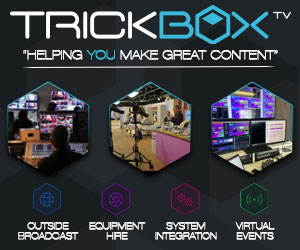Broadcast News
12/11/2014
Helium? Shingles? What's That Got To Do With Archiving?!

It's human nature to judge the new in terms of what we already know, especially when an innovation challenges established concepts, writes Alan Hoggarth, MD, Disk Archive Corporation.
In terms of large-scale storage for media content and other forms of data, conventional wisdom has it that certain types of storage technology are only good for certain roles. Disk is for immediate access in NAS or SAN configurations, and tape is for long-term storage. The inherent characteristics of tape and disk seem to define these roles, and storage strategies for the broadcast industry (and others) have evolved accordingly.
But what if those 'inherent characteristics' change to allow one technology to step out of its role and play more than one part? This is exactly what has happened in the case of storage, where disk technology is developing and mutating in ways that allow disks to be used for archive and content library applications. It's a little counter-intuitive perhaps to think of infrequently-accessed content being stored on spinning disks, but this is essentially where the change has come about: the disks in a disk archive only spin up on demand. This apparently simple change has profound consequences.
Naturally there's an acronym for an array of disks designed to provide very large storage capacity with low power consumption by spinning up and down as required. MAID-III (Massive Array of Independent Disks) is actually the third evolution of the idea, superseding MAID-I and MAID-II, both of which were RAID based and offered relatively little in the way of benefits. In MAID-III, each disk in the massive array is totally independent, and can be started and stopped individually for reading and writing when needed.
The ALTO storage system uses MAID-III technology, and as a solution for storing infrequently-accessed content it offers many advantages over tape libraries, and over other forms of disk-based storage such as simple RAID NAS systems. Comparing the pros and cons of tape libraries and NAS solutions, it's clear that neither is ideal. Robotic tape libraries are expensive for small archives, but NAS is expensive for large ones. The immediate access of a NAS solution isn't required for archives, but the media access time of a robotic tape library is too long.
Robotic tape libraries need downtime, and NAS disks only have a short operational life. With tapes you know where your media is located, but you need an expensive device to access them locally. Tape robots use less power and dissipate less heat than NAS, but tape and mechanical maintenance costs are high.
ALTO's MAID-III technology gives much faster access to the content than tape, maintenance requirements are much lower and maintenance is simpler than with tape or NAS. Files are written to individual media so you can take your content out of the system on a single disk (and address it with any PC if you need to), and the disks are idle until needed so they last longer and there's much lower power consumption.
This combination of talents makes MAID-III very suitable not just as an alternative for data-tape archiving, but also as a way of combining the archive function with cost-effective cache storage for news production and post-production workflows, content libraries for VOD, or to feed HD/SD integrated playout solutions.
With ALTO you only have to populate the frame with as many disks as you need now, and can add others later, getting more TB for your money each year, or the same TB for less money.
The technology allows users to source their own disks to populate the array, and disks can be added individually as and when more capacity is needed, allowing expansion to come out of OPEX budgets. And since disk development is being driven by massive online data centers, the capacity of an array can increase rapidly as newer, larger disks are added.
Driven by the huge demand from Data Centers, disk technology is developing in a way that is making ALTO even more attractive for media storage. A single 3.5-inch hard drive can now store up to 6TB of data in a sealed, helium-filled enclosure. The helium generates less turbulence than air, allowing a closer head to disk interface and more densely packed platters, giving enterprise-class performance in an inert environment, totally protected from atmospheric dust and humidity.
Surprisingly the lower turbulence of the helium translates to 50% lower power consumption, further reducing the TCO of the Archive. Another new technology, eminently suitable for deep archives and preservation is Shingled Magnetic Recording which reduces the recording track width to squeeze even more data onto the platters. SMR is bringing massive increases in capacity with access times and workload capabilities that are spot-on for ALTO.
With the rapid pace of development, the dilemma could be when to jump on board with any new technology without the usual "buyer remorse" when something bigger and better comes along. This is where another important attribute of the ALTO architecture comes into play with the ability to mix different disk capacities from any of the principal vendors in any slot, so it's a case of buy-as-you-go, not buy and regret!
Year by year, archives and content libraries become more important and central to the media industry. MAID-III offers both immediate and long-term advantages: easy to integrate into production, backup and other workflows, with low total cost of ownership, high performance, and low environmental impact, MAID-III can play a lot of roles outstandingly well.
The article is also available to read in BFV online.
(IT/JP)
In terms of large-scale storage for media content and other forms of data, conventional wisdom has it that certain types of storage technology are only good for certain roles. Disk is for immediate access in NAS or SAN configurations, and tape is for long-term storage. The inherent characteristics of tape and disk seem to define these roles, and storage strategies for the broadcast industry (and others) have evolved accordingly.
But what if those 'inherent characteristics' change to allow one technology to step out of its role and play more than one part? This is exactly what has happened in the case of storage, where disk technology is developing and mutating in ways that allow disks to be used for archive and content library applications. It's a little counter-intuitive perhaps to think of infrequently-accessed content being stored on spinning disks, but this is essentially where the change has come about: the disks in a disk archive only spin up on demand. This apparently simple change has profound consequences.
Naturally there's an acronym for an array of disks designed to provide very large storage capacity with low power consumption by spinning up and down as required. MAID-III (Massive Array of Independent Disks) is actually the third evolution of the idea, superseding MAID-I and MAID-II, both of which were RAID based and offered relatively little in the way of benefits. In MAID-III, each disk in the massive array is totally independent, and can be started and stopped individually for reading and writing when needed.
The ALTO storage system uses MAID-III technology, and as a solution for storing infrequently-accessed content it offers many advantages over tape libraries, and over other forms of disk-based storage such as simple RAID NAS systems. Comparing the pros and cons of tape libraries and NAS solutions, it's clear that neither is ideal. Robotic tape libraries are expensive for small archives, but NAS is expensive for large ones. The immediate access of a NAS solution isn't required for archives, but the media access time of a robotic tape library is too long.
Robotic tape libraries need downtime, and NAS disks only have a short operational life. With tapes you know where your media is located, but you need an expensive device to access them locally. Tape robots use less power and dissipate less heat than NAS, but tape and mechanical maintenance costs are high.
ALTO's MAID-III technology gives much faster access to the content than tape, maintenance requirements are much lower and maintenance is simpler than with tape or NAS. Files are written to individual media so you can take your content out of the system on a single disk (and address it with any PC if you need to), and the disks are idle until needed so they last longer and there's much lower power consumption.
This combination of talents makes MAID-III very suitable not just as an alternative for data-tape archiving, but also as a way of combining the archive function with cost-effective cache storage for news production and post-production workflows, content libraries for VOD, or to feed HD/SD integrated playout solutions.
With ALTO you only have to populate the frame with as many disks as you need now, and can add others later, getting more TB for your money each year, or the same TB for less money.
The technology allows users to source their own disks to populate the array, and disks can be added individually as and when more capacity is needed, allowing expansion to come out of OPEX budgets. And since disk development is being driven by massive online data centers, the capacity of an array can increase rapidly as newer, larger disks are added.
Driven by the huge demand from Data Centers, disk technology is developing in a way that is making ALTO even more attractive for media storage. A single 3.5-inch hard drive can now store up to 6TB of data in a sealed, helium-filled enclosure. The helium generates less turbulence than air, allowing a closer head to disk interface and more densely packed platters, giving enterprise-class performance in an inert environment, totally protected from atmospheric dust and humidity.
Surprisingly the lower turbulence of the helium translates to 50% lower power consumption, further reducing the TCO of the Archive. Another new technology, eminently suitable for deep archives and preservation is Shingled Magnetic Recording which reduces the recording track width to squeeze even more data onto the platters. SMR is bringing massive increases in capacity with access times and workload capabilities that are spot-on for ALTO.
With the rapid pace of development, the dilemma could be when to jump on board with any new technology without the usual "buyer remorse" when something bigger and better comes along. This is where another important attribute of the ALTO architecture comes into play with the ability to mix different disk capacities from any of the principal vendors in any slot, so it's a case of buy-as-you-go, not buy and regret!
Year by year, archives and content libraries become more important and central to the media industry. MAID-III offers both immediate and long-term advantages: easy to integrate into production, backup and other workflows, with low total cost of ownership, high performance, and low environmental impact, MAID-III can play a lot of roles outstandingly well.
The article is also available to read in BFV online.
(IT/JP)
Top Related Stories
Click here for the latest broadcast news stories.
20/03/2014
Singing Praises: Disk Archive And ALTO Architecture
Established in 2009, Disk Archive Corporation specialises in developing and supporting high capacity, high availability solutions for long-term storag
Singing Praises: Disk Archive And ALTO Architecture
Established in 2009, Disk Archive Corporation specialises in developing and supporting high capacity, high availability solutions for long-term storag
15/12/2014
Televisión Canaria Migrates Archive To An LTO All-Disk Storage System
Televisión Canaria has migrated its entire archive from LTO tape to an ALTO all-disk storage system from Disk Archive Corporation. Initially configure
Televisión Canaria Migrates Archive To An LTO All-Disk Storage System
Televisión Canaria has migrated its entire archive from LTO tape to an ALTO all-disk storage system from Disk Archive Corporation. Initially configure
08/06/2016
Tapeless Archiving Made Easy
For more than 30 years, data tape in one form or another was the most logical choice for archiving media across various industries. Tape offered the c
Tapeless Archiving Made Easy
For more than 30 years, data tape in one form or another was the most logical choice for archiving media across various industries. Tape offered the c
24/01/2007
Bryco Tape Storage Provides Storage Solution For Hospital
Bryco storage containers have created a tidy and efficient work space in the medical illustration department at Heart of England NHS Foundation Trust.
Bryco Tape Storage Provides Storage Solution For Hospital
Bryco storage containers have created a tidy and efficient work space in the medical illustration department at Heart of England NHS Foundation Trust.
12/12/2017
Broadcasters & Post Production Facilities Digitising Legacy Tape Formats: Pt 4
The fourth in a series of articles by Pat Horridge of VET Training covering the issues facing broadcasters & post houses needing to digitise legacy ta
Broadcasters & Post Production Facilities Digitising Legacy Tape Formats: Pt 4
The fourth in a series of articles by Pat Horridge of VET Training covering the issues facing broadcasters & post houses needing to digitise legacy ta
04/12/2017
Broadcasters & Post Production Facilities Digitising Legacy Tape Formats: Pt 3
Broadcasters & Post Production Facilities Digitising Legacy Tape Formats The third in a series of articles by Pat Horridge of VET Training covering th
Broadcasters & Post Production Facilities Digitising Legacy Tape Formats: Pt 3
Broadcasters & Post Production Facilities Digitising Legacy Tape Formats The third in a series of articles by Pat Horridge of VET Training covering th
24/11/2004
Hammer to distribute Infortrend’s disk storage solutions
Disk-quality storage for the price of tape is to become a reality as Hammer spearheads the distribution of second-generation Serial ATA (SATA) RAID st
Hammer to distribute Infortrend’s disk storage solutions
Disk-quality storage for the price of tape is to become a reality as Hammer spearheads the distribution of second-generation Serial ATA (SATA) RAID st
14/11/2019
Sony Launches Optical Disk Archive Generation 3
Sony Professional Solutions Europe has launched Optical Disc Archive Generation 3, the latest version of high capacity archive drive inclusive of USB
Sony Launches Optical Disk Archive Generation 3
Sony Professional Solutions Europe has launched Optical Disc Archive Generation 3, the latest version of high capacity archive drive inclusive of USB
18/05/2017
Awards Win For Disk Archive
Disk Archive has been named the winner of 2017 Red Herring Top 100 Europe Award. The Red Herring Top 100 Europe enlists entrepreneurs and promising co
Awards Win For Disk Archive
Disk Archive has been named the winner of 2017 Red Herring Top 100 Europe Award. The Red Herring Top 100 Europe enlists entrepreneurs and promising co
02/09/2014
Disk Archive Launches ALTO Expansion At IBC2014
Disk Archive Corporation (IBC Booth 8.B38F) has launched a new expansion chassis for its ALTO tapeless long-term storage system. The EX-60 Storage Exp
Disk Archive Launches ALTO Expansion At IBC2014
Disk Archive Corporation (IBC Booth 8.B38F) has launched a new expansion chassis for its ALTO tapeless long-term storage system. The EX-60 Storage Exp
12/11/2019
LTO Ultrium Tape…A Breakthrough Product In Data Storage
PMD Magnetics is one of the longest standing suppliers of LTO tape media in Europe, starting the business back in 1977. Managing Director, Geoff Dance
LTO Ultrium Tape…A Breakthrough Product In Data Storage
PMD Magnetics is one of the longest standing suppliers of LTO tape media in Europe, starting the business back in 1977. Managing Director, Geoff Dance
16/07/2012
Crossroads Systems StrongBox Enterprise LTFS NAS
The Crossroads StrongBox is available from Fortuna PS is an online all-the-time, non-proprietary and fully portable data vault for long-term data rete
Crossroads Systems StrongBox Enterprise LTFS NAS
The Crossroads StrongBox is available from Fortuna PS is an online all-the-time, non-proprietary and fully portable data vault for long-term data rete
23/01/2002
Holdan introduce improved video disk technology
HOLDAN will be showcasing their new Datavideo VDR-3000 video disk recorder at VideoForum 2002. The VDR-3000 offers an alternative to recordable DVD, r
Holdan introduce improved video disk technology
HOLDAN will be showcasing their new Datavideo VDR-3000 video disk recorder at VideoForum 2002. The VDR-3000 offers an alternative to recordable DVD, r
05/09/2011
SGL Demonstrates Archive Support For Linear Tape File System
A provider of content archive and storage management software for media and entertainment will highlight its unrivalled support for the ground-breakin
SGL Demonstrates Archive Support For Linear Tape File System
A provider of content archive and storage management software for media and entertainment will highlight its unrivalled support for the ground-breakin
15/11/2017
Broadcasters & Post Production Facilities Digitising Legacy Tape Formats: Pt 2
The second in a series of articles by Pat Horridge of VET Training covering the issues facing broadcasters & post houses needing to digitise legacy ta
Broadcasters & Post Production Facilities Digitising Legacy Tape Formats: Pt 2
The second in a series of articles by Pat Horridge of VET Training covering the issues facing broadcasters & post houses needing to digitise legacy ta















